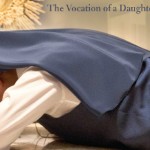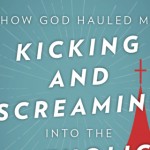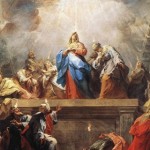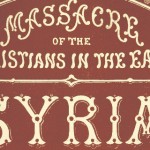By Sr. Anne Flanagan
Sister Julia came to my office the other day with a real find: “Sister Anne, I found your Jesus in the basement!”
No, the Blessed Sacrament had not transported itself from the chapel. But I still went down to the basement of the “Promised Land” building to bring my Jesus back upstairs.
There he was, mounted on smooth wood, an art print long faded by the sunlight: the Christ of Sinai. The icon had been a gift to our community from the nearby Transfiguration Monastery and had hung on the wall outside of chapel long enough to turn its coloring to shades of blue and yellow (at which point it must have been relocated to the basement). It’s not that I hadn’t seen the image in years: I have a life-sized print of it in my room and holy card versions in every prayerbook I use on a regular basis. There are three copies in my Liturgy of the Hours alone! I even have an 8 x 11 version I take with me on trips. (All those years of passing by the icon on my way to chapel must have “imprinted” on me.)
There’s an interesting quality to this image that I didn’t really notice until it was pointed out to me. The face of Jesus, so majestic, is really made of two slightly unmatched halves, each of which communicates a different emotional quality. In fact, I have noticed that what I see when I look at the icon depends very much on my state of soul! When I am interiorly out of sorts, that arched eyebrow seems to heighten as if to invite me to consider what may be coming between me and the Lord.
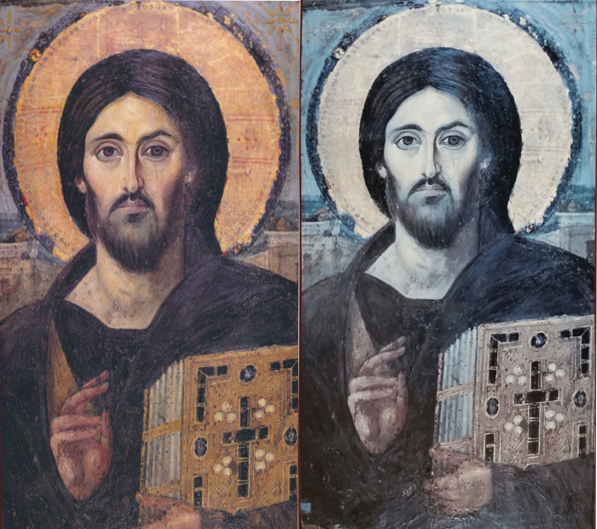
On Right: “My” Jesus: The icon that hung outside of chapel (now in my office).
On Left: This image gives you a better sense of the full beauty of the icon.
There are many remarkable features hidden in this icon. First of all its style: while there are certainly aspects that we might associate with Eastern icons, there is a kind of physicality to the painting that is not at all typical. It seems a cross between a portrait and an icon.
Then there is that dual quality to the face: On the left (as we see it), there is a serene, almost two-dimensional face; on the right, the features are irregular: the eyebrow is arched, the nostril prominent, the cheek featuring shadowing that implies a set jaw. Some interpretations of this duality see the right side of the face as reflecting Christ’s suffering during his Passion, with a broken nose and contusions over his eye, while the left side seems to image the Risen Christ. Another approach sees the strongly three-dimensional right side as communicating Christ’s human nature, and the unworldly two-dimensional left as a portrayal of his divine nature.
But then there is the book, sealed shut. Is that the “book of life” (see Rev. 3:5)? That could make this an image of Christ on Judgment Day. He is both the tender shepherd who tells the sheep on his right (our left) “Come, you whom my Father has blessed: inherit the Kingdom prepared for you from the foundations of the earth!” But to the “goats” on his left (our right), “the King” will say, “Depart from me…for I was hungry and you gave me no food, thirsty and you gave me no drink” (Mt 25: 31-46).
Scholars believe that this image was probably painted in Constantinople sometime around the year 600, and may have even been commissioned by an emperor. (Constantinople was the capitol of the Byzantine Empire.) In a move that saved it from the ravages of the iconoclasts (“icon-breakers”), the image seems to have been transferred early on to St Catherine’s Monastery on Mount Sinai in faraway Egypt, where it is venerated to this day. No one knows who “wrote” this incredible icon, but it was clearly a person who put his (or her?) magnificent talent at the service of the Holy Spirit.
When we place ourselves at the service of God, whatever we do, no matter how insignificant it seems, can echo through the centuries as grace for others.
 Sister Anne Flanagan, a Daughter of St Paul, a native of New Orleans, is author of Five Keys to Understanding Pope Francis. She has also recorded over two dozen albums as a soprano in the Daughters of St Paul choir. Follow her on Twitter @nunblogger. She blogs at Nun Blog.
Sister Anne Flanagan, a Daughter of St Paul, a native of New Orleans, is author of Five Keys to Understanding Pope Francis. She has also recorded over two dozen albums as a soprano in the Daughters of St Paul choir. Follow her on Twitter @nunblogger. She blogs at Nun Blog.
This post first appeared in the Daughters of St. Paul My Discover Hope weekly email; if you would like to subscribe to our sisters weekly email, you can do so here.



